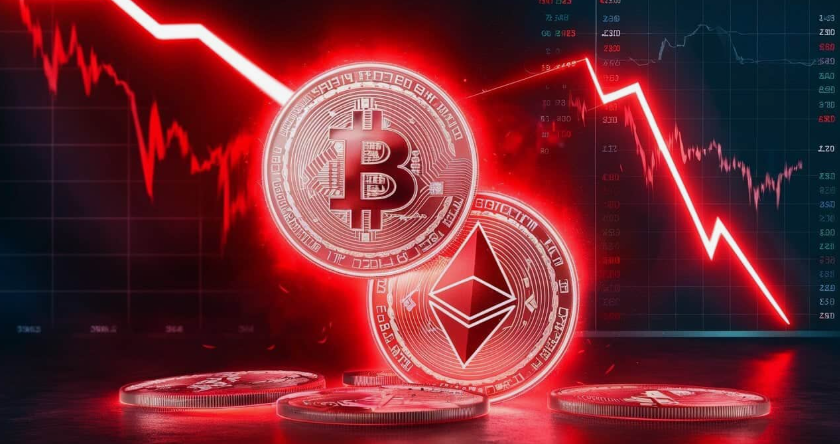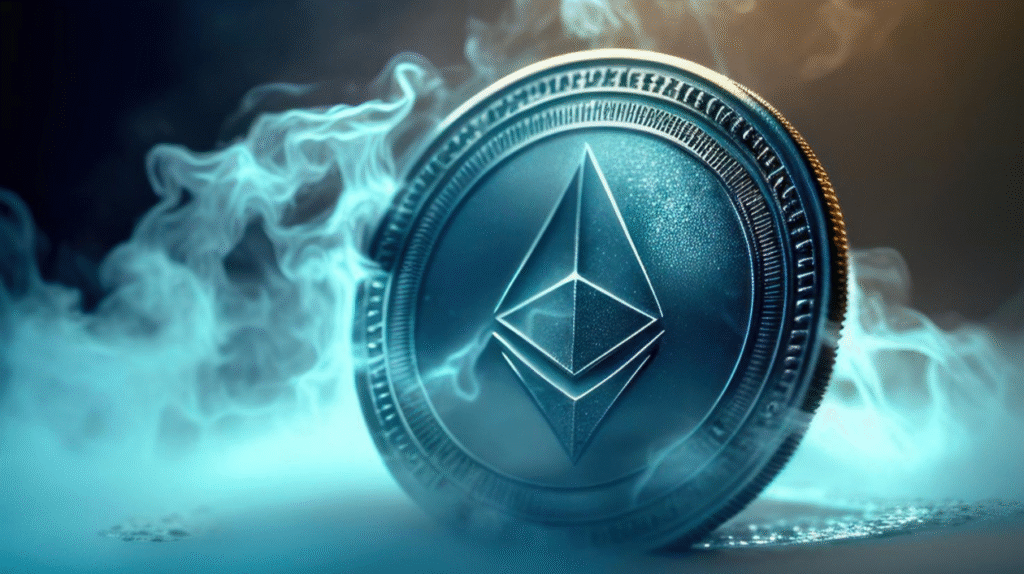Crypto researchers and traders worldwide are interested in the concept of “altcoin season.” Recent data indicate that Ethereum is outperforming Bitcoin, with Bitcoin’s market share declining. This evidence adds to the notion that a strong altseason may be on the horizon. XRP Futures ETF, The changes in BTC dominance charts, Ethereum’s remarkable rise, and the increasing altseason index all provide an intriguing backdrop for examining whether this cycle could herald the next big step in the crypto bull market.
Ethereum is gaining ground as BTC’s dominance fades
The BTC dominance ratio, which represents the percentage of Bitcoin’s share in the total market capitalization, has declined from a high of 65% to approximately 62% over the last few weeks. In the past, these drops in dominance have coincided with capital moving into altcoins, which are tokens other than Bitcoin, such as Ethereum, Solana, and XRP. In May 2025, Ethereum’s value increased by approximately 47%, while Bitcoin’s value rose by about 9%. This could mean that investors are changing their minds.
The ETH/BTC trading pair is powerful, which adds to Ether’s bullish performance. Over the last month, ETH/BTC has increased by over 46–48%, with technical resistance levels at 0.025–0.026 BTC indicating key areas. CryptoQuant notes that the ETH/BTC ratio has bounced back from its lowest point in the past, which could be a sign of a positive turning point.
At the same time, some experienced experts, such as Peter Brandt, have suggested that Bitcoin’s double top formation and bearish RSI divergence could indicate a sharp decline in BTC dominance. Additionally, indices such as the Altseason Index, which tracks the market value of cryptocurrencies other than Bitcoin, have surpassed $1.2 trillion, demonstrating the strength of this emerging trend.
Why ETH’s better performance means a bigger altseason
When Ethereum rises and Bitcoin remains stable or declines, it typically leads to larger altcoin rallies. When ETH/BTC breaks over resistance levels, which commonly happens with chart patterns like cup-and-handle or bull flags, it signifies the start of altseason.
The new Pectra network update for Ethereum has sparked even greater interest among investors. This major update, the largest since “The Merge,” made it easier to scale, stake, and reduce gas costs. In May alone, Ether’s price increased by 45%. Ethereum is becoming increasingly recognized as both a hub for technological innovation and a key driver of DeFi growth, as the use of smart contracts continues to expand.
On-chain indicators suggest that Ethereum is performing well, with daily active addresses increasing by 12% and open interest in Ethereum derivatives exceeding $25 billion. These indicators point not only to retail speculation but also to a significant amount of institutional money moving into altcoins, which is an indication of a mature, capital-driven altseason.
Historical Context of Altcoin Seasons
| Period | BTC Dominance Start | BTC Dominance Low | Duration | Key Drivers |
|---|---|---|---|---|
| 2017-2018 | 86% | 39% | 12 months | ICO boom, Ethereum growth |
| 2020-2021 | 64.8% | 39% | 8 months | DeFi explosion, NFT mania |
| 2025 (Current) | 65% | 62% (ongoing) | TBD | Pectra upgrade, ETH staking |
Ethereum’s Stellar Performance: The Catalyst for Change
ETH/BTC Ratio Breaks Key Resistance
Ethereum’s remarkable performance against Bitcoin has been the standout story of 2025. The ETH/BTC trading pair has surged over 46-48% in the past month, with technical analysts identifying key resistance levels at 0.025-0.026 BTC.
Market Sentiment and Technical Indicators
This story is backed up by technical analysis. BTC dominance charts indicate a weakening structure, whereas altcoin dominance and ETH/BTC charts display breakout patterns. Sentiment indices, such as Bitwise’s Altseason Index, increased from 15 to 85, and 80% of the tracked altcoins are currently performing better than Bitcoin. At the same time, analysts like Zach Pandl from Grayscale warn that BTC.D may remain between 60% and 70%, indicating that a significant rise in altcoins requires a higher level of macroeconomic risk appetite.

The fact that ETH/BTC is increasing and BTC dominance is decreasing encourages the continuous movement of capital into altcoins. Historically, each new cryptocurrency rally signifies a new stage in the crypto cycle: Bitcoin leads, Ethereum follows, and then lesser-known tokens rise. This cyclical pattern appears to align with the current market conditions.
What This Means for Investors and Traders
Both individual investors and institutions should see these changes as part of a staged capital deployment strategy. When ETH outperforms BTC and then some people start buying mid-cap and niche cryptocurrencies, it’s a hint that an early-stage altseason is coming. For anyone who wants to control their risk, Ethereum’s Pectra upgrade and Ether staking returns may be good times to get in. As more people use ETH, exposure to protocols in DeFi, NFTs, and layer-2 scaling may lead to even better returns.
From an institutional perspective, Ethereum is now the preferred alternative to Bitcoin for strategic capital allocation due to its staking yields, clear regulations, and improved energy efficiency following the Merge. Ethereum’s function as programmable money is becoming stronger as tokenized municipal bonds, NFTs, tokenized securities, and on-chain lending platforms become more common.
Retail traders, on the other hand, should keep an eye on the ETH/BTC ratio, the BTC.D breaking below 60%, and the rise in altcoin volume. When significant altcoins are oversold and macro risk sentiment changes (such as when US-China trade tensions ease or the Fed’s tone becomes more dovish), it typically leads to huge short-term gains.
Past Altcoin Seasons
In the last few years, there have been two big alt seasons: 2017–18 and 2020–21. Bitcoin’s market share declined from approximately 86% to less than 39% between 2017 and 2018, allowing altcoins to grow. The ICO craze led to a rapid rise in Ethereum-based coins. The DeFi and NFT boom of 2020–21 followed a rapid decline in BTC.D from 64.8% to approximately 39%.
The current situation shares many similarities with the past: BTC dominance is declining, ETH/BTC momentum remains strong, macroeconomic conditions are improving, and the network is evolving for the better. This cycle, on the other hand, features unique characteristics such as staking economies, institutional crypto ETFs, and composable DeFi infrastructure, which provide more structural support for prolonged altcoin seasons.
Possible Risks and Arguments Against
Even when there are signs that things are going well, people are still skeptical. Analysts say that Bitcoin’s dominance may level out, and macroeconomic instability (such as inflation or the Fed’s signals) could cause investors to move their money back to safe-haven BTC. If ETH/BTC remains at a plateau or dominance stays above key levels, an altseason might not start immediately.
For altcoins to outperform Bitcoin, technical resistance points must be broken. These include the ETH/BTC chart’s 0.026–0.030 BTC and the BTC dominance support at 60%. The move could fade if ETF inflows cease or if on-chain utility gains aren’t substantial.
Finally, even though Ethereum is the most popular token, altseason isn’t just about big-cap tokens. Smaller networks and niche DeFi projects may fall behind until the general mood shifts to being more risk-on.
FAQs
What is altcoin season, and how long does it typically last?
Altcoin season refers to a period when alternative cryptocurrencies (altcoins) significantly outperform Bitcoin. Historically, these periods have lasted 8-12 months, with notable examples including 2017-2018 and 2020-2021. The duration depends on various factors, including market sentiment, technological developments, and macroeconomic conditions.
How can I identify the start of the altcoin season?
Key indicators include: Bitcoin dominance declining below 60-62%, ETH/BTC ratio breaking above key resistance levels, increased trading volume in altcoins, and sentiment indices like the Altseason Index showing readings above 75. Additionally, watch for institutional money flowing into altcoins and positive developments in DeFi and other blockchain ecosystems.
Which altcoins typically perform best during altcoin season?
Large-cap altcoins like Ethereum, Solana, and Cardano often lead the charge, followed by mid-cap projects with strong fundamentals and utility. DeFi tokens, layer-2 solutions, and projects with real-world applications tend to outperform. However, smaller projects can see explosive growth during peak altcoin season phases.
What risks should I consider when investing during altcoin season?
Major risks include extreme volatility, regulatory uncertainty, technical failures, and potential market manipulation. Altcoins can experience rapid 50-80% corrections even during bull markets. It’s crucial to use proper position sizing, set stop losses, and never invest more than you can afford to lose.
How does Ethereum’s Pectra upgrade impact altcoin season prospects?
The Pectra upgrade significantly improves Ethereum’s scalability, reduces gas costs, and enhances staking capabilities. This makes Ethereum more attractive to both retail and institutional investors, potentially accelerating capital flow from Bitcoin to Ethereum and subsequently to other altcoins built on the Ethereum ecosystem.
Can Bitcoin and altcoins both perform well simultaneously?
While this is possible, historically, Bitcoin and altcoins have shown an inverse correlation during major market cycles. When Bitcoin dominance rises, altcoins typically underperform, and vice versa. However, during broad crypto bull markets, both can appreciate, though altcoins usually outperform during their specific season phases.


